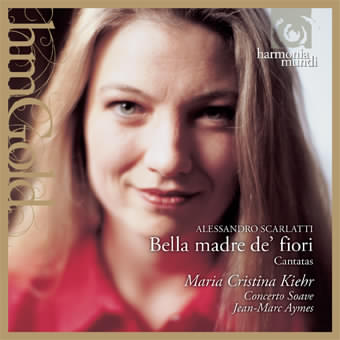Texte paru dans: / Appeared in: |
|
|
Reviewer: Brian
Robins All three of these chamber cantatas have received previous recordings, Correa nel sono amato on an attractive Hyperion disc sung by Lynne Dawson dating back to 1987 (CDA66254), while the other two were included on the first of four DHM volumes devoted to Scarlatti's cantatas. At face value this duplication might seem rather a pity when only a fraction of the 600-odd cantatas have been recorded, but in fact Kiehr's disc has so much to offer that any initial disappointment is rapidly dissipated. Ostensibly the Scarlattian chamber cantata is a straightforward form, an alternation of recitative and aria nearly always concerned with the loves and losses of shepherds and shepherdesses who people an idealized Arcadian world. Yet the genre poses considerable problems for both performers and today's audiences, the latter because these are works originally designed for the highly discerning patrons of Roman and other accadèmia, the former because there is a tendency among singers to look upon the cantatas as miniature opera scenas whose prime requirement is a bel canto technique. This I found to be a major problem with Christine Brandes's singing on the DHM disc (Fanfare 21:2), which, yes, is beautiful, but also relatively uninvolved. Kiehr's major achievement is to have recognized that truly to reach the heart of these works, the singer must use techniques as far removed from the opera house as are those of Lieder singing. Unlike Brandes (and to a lesser extent Dawson) she has realized that the expressive recitatives perform quite a different function, elevating them to a status as important as the arias. Her rhetorical use of affetti is remarkable throughout, with key words subtly colored and inflected in a way not attempted by her rivals. And what a marvelous storyteller she proves to be in the extended narrative recitative recounting the miseries of the lovelorn Daliso in Correa nel sono amato, drawing the listener inexorably into the twilight scene as empathetic observer. The succeeding aria, in which the shepherd voices his grief, is not only intensely moving, but also bravely taken at an extraordinarily slow tempo (half that of Dawson) justified by Kiehr's rock-steady cantabile line. If Correa nel sono amato is arguably the finest of these cantatas, the other two are scarcely less impressive. The brief Poi che riseppe Orfeo captures the grief of Orpheus's loss within the space of three succinct arias, the last seamlessly developing out of recitative to a new mood of confidence as Orpheus places his faith in the power of his song. Lack of formulaic stereotypes is in fact a feature of each of these cantatas, which include strophic and through-composed arias, and arioso in addition to the expected da capos. So, you may surmise, we have an outright winner on our hands? Well, sadly not quite, I'm afraid. Both Correa nel sono amato and Bella Madre de'fiori include important obbligato parts for two violins and opening sinfonias, an exquisitely lovely sustained movement in the case of Bella Madre de'fiori. Although the playing of Concerto Soave's violinists is stylish and sensitive, their tonal quality is harsh and no match for that on either of the other two discs mentioned (indeed, compared to this the playing of the Purcell Quartet's violinists on Dawson's recording makes a mockery of the theory that period string playing has universally improved over the last 15 or so years). The continuo group, which includes both harp and archlute, is fine. Less than ingratiating violin tone is not going to prevent me recommending the disc for Kiehr's splendid interpretations, but it does mar what would otherwise be the best recording of Scarlatti cantatas I've encountered to date. | |
|
|
|
|
|
|
|
Cliquez l'un ou l'autre
bouton pour découvrir bien d'autres critiques de CD |
|
.jpg)



